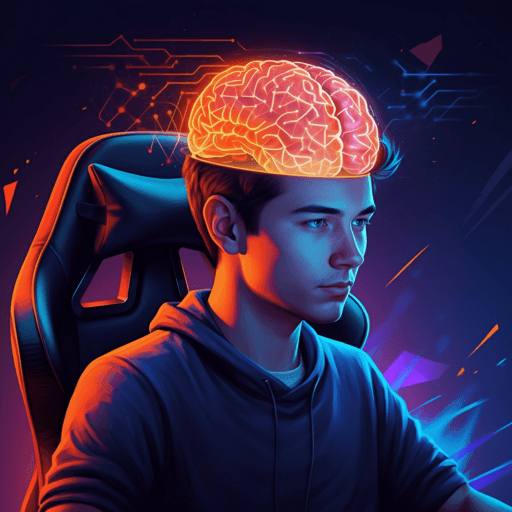
Psychology
Single video games improve cognitive functioning in college students: evidence from behavioral and fNIRS assessments
C. Li, X. Guo, et al.
A single session of cognitively engaging video gaming produced immediate cognitive gains—faster reactions, higher accuracy, and improved decision-making—linked with increased prefrontal activation (bilateral OFC and left DLPFC) measured by fNIRS. Research conducted by Chuangtao Li, Xiaodan Guo, Jingsong Wang, and Shen Wang.
~3 min • Beginner • English
Introduction
Cognitive function underpins learning, socializing, and daily life in college students. League of Legends (LOL), a widely played MOBA game, is highly interactive and requires advanced cognitive skills such as visual selectivity, multi-target tracking, and executive function, making it a valuable paradigm in cognitive neuroscience. Prior research demonstrates that video game training can improve visual attention, information processing speed, visuospatial attention, and information filtering, and induces functional and structural plastic changes across prefrontal, parietal, hippocampal, and broader network levels. Functional near-infrared spectroscopy (fNIRS) is a portable, non-invasive method to assess prefrontal cortex (PFC) activity through Oxy-Hb/Deoxy-Hb changes and has been applied to gaming-related brain mechanism research. While correlations between gaming and PFC plasticity (e.g., left DLPFC cortical thickness, PFC white matter properties) have been observed, the immediate effects of a single gaming session are underexplored. Single-session paradigms isolate state changes from longer-term learning or structural adaptations and align with neuromodulatory time scales such as dopamine release during gameplay. Some evidence suggests acute cognitive benefits after brief gaming (e.g., improved alerting network efficiency), but immediate brain mechanisms in college students remain unclear. Few longitudinal studies show DLPFC/OFC/striatal adaptations after weeks to months of training, leaving open whether a single session can alter behavioral responses and PFC activation. This study fills that gap by synchronizing behavioral (RT, ACC) and fNIRS (Oxy-Hb) measurements pre/post a 1-hour session. Hypotheses: (1) Behaviorally, VG would show shorter RT, higher ACC, and greater RCS post-test; nVG would show the opposite. (2) Neurally, VG would show increased PFC activation post-test versus pre-test and higher than nVG.
Literature Review
Prior work indicates video game training enhances perceptual, attentional, and cognitive skills, including visual attention, processing speed, visuospatial attention, and information filtering. Neuroimaging shows gaming-related plasticity in PFC, parietal cortex, hippocampus, and networks, with associations between playtime and left DLPFC cortical thickness and PFC white matter integrity. Longitudinal studies report training-induced changes in functional activity, resting-state connectivity, and gray matter/cortical thickness in DLPFC, OFC, and striatum. Acute neuromodulation (e.g., striatal dopamine release) during gameplay supports state-level effects compatible with single-session paradigms. However, immediate cognitive and PFC activation changes from a single gaming session in college students have been less systematically examined, motivating synchronized behavioral and fNIRS assessments.
Methodology
Design: Randomized controlled pre/post design with two groups: video game (VG) intervention vs. non-video game (nVG) control. Timeline: pre-test (behavior + fNIRS), 1-hour intervention, post-test (behavior + fNIRS). Assessments lasted ~12 min each; 10-min breaks; total experiment ~100 min.
Participants: Forty-three right-handed male college students from Fuzhou, China (VG: n=22, 21.0 ± 1.9 y; 177.0 ± 4.6 cm; 67.7 ± 8.0 kg; nVG: n=21, 20.6 ± 1.6 y; 177.5 ± 6.0 cm; 70.1 ± 7.3 kg). Inclusion: male; LOL play ≥6 months, >5 h/week; rank ≥ Gold; normal or corrected vision; right-handed; no stimulant intake before testing. Exclusion: CNS disease; cognitive dysfunction; concurrent similar screen exposure studies. Ethics: Approved by Fujian Normal University Ethics Committee (FNV-2025003); informed consent obtained; compensation provided.
Stimuli and task: Cognitive function measured via a picture categorization task (emotional valence: positive, neutral, negative) from Chinese Affective Picture System (CAPS). Eighty images per valence (validated valence/arousal ratings; significant valence differences, nonsignificant arousal differences). E-Prime 2.0 presented 5 blocks × 48 trials; images standardized (433×328 px) on a 15.6-inch laptop (1024×768 dpi), black background; viewing distance 50–70 cm.
Behavioral task procedure: Each trial: 500 ms fixation, 1000 ms image presentation with immediate valence judgment (keys: D=positive, F=neutral, J=negative), 600–800 ms inter-trial interval. Missing responses excluded. Practice: 2 min. Block rest: 15 s. Outcomes: Reaction time (RT), accuracy (ACC), and response correctness score (RCS = correct responses/total response time).
Intervention: VG group completed 10 min standardized practice, then played League of Legends for 1 hour with full attention on a lab computer. Character selection controlled (novice character to minimize familiarity). Strict 60-min duration; sessions with <60 min excluded; only games with clear outcome included. nVG group watched 1 hour of pre-selected LOL gameplay videos in the same setting to match visual/auditory content, task semantics, event pacing, and screen exposure time, differing only in active manipulation/decision-making.
fNIRS acquisition: Continuous-wave system with 11 light sources (760 and 850 nm) and 11 detectors arranged on a 2×11 grid, 3 cm spacing, forming 31 channels covering PFC; sampling at 11 Hz. Montage referenced to 10–20 system and standardized spatial registration/probability tools to map channels to PFC subregions. Key channel-region mapping included OFC (channels 6, 7, 9, 10) and DLPFC (17, 18, 19, 29, 30, 31), among others.
Synchronous recording: E-Prime (Computer A) and fNIRS (Computer B) linked via LAN for synchronized triggers and timestamps upon stimulus onset and behavioral responses.
Data preprocessing:
- Behavioral: RT analyzed only for correct trials. Exclusions: RT <150 ms or >1500 ms and values outside mean ±3 SD (per participant/task). RCS computed as correct responses divided by total response time.
- fNIRS: Preprocessed in NirSpark V1.5.20. Motion artifacts corrected using wavelet-based method; band-pass filtered (0.01–0.2 Hz). Optical density converted to concentration changes via modified Beer–Lambert law. Analyses focused on Oxy-Hb due to sensitivity/reliability. For each channel, mean Oxy-Hb across trials computed for pre/post conditions.
Statistical analysis: Descriptive statistics (mean ± SD; counts as n[%]); outliers assessed by Q–Q plots. Normality (Shapiro–Wilk) and homogeneity (Levene) confirmed (P>0.05). Repeated-measures ANOVA with factors time (pre, post) × group (VG, nVG); Bonferroni-corrected simple effects for significant interactions. Effect sizes reported as partial eta squared (ηp²), interpreted as small/medium/large at 0.01/0.06/0.14. Significance threshold p<0.05. Software: SPSS v28.
Key Findings
Behavioral outcomes (n=43):
- Reaction time (RT): Significant main effects of group F(1,41)=45.6, p<0.01, ηp²=0.5; time F(1,41)=9.9, p<0.01, ηp²=0.2; and group×time interaction F(1,41)=114.5, p<0.01, ηp²=0.7 (large). Simple effects: VG post-test RT decreased by 52.0 ms (p<0.01; 95% CI: 2.38–3.59 for standardized contrasts); nVG post-test RT increased by 28.4 ms (p<0.01; 95% CI: −2.25–1.01). Between-group post-test difference: 95.4 ms (p<0.01; 95% CI: −6.52 to −4.45).
- Accuracy (ACC): Significant main effects of group F(1,41)=15.9, p<0.01, ηp²=0.3; time F(1,41)=9.9, p<0.01, ηp²=0.2; and interaction F(1,41)=166.4, p<0.01, ηp²=0.8 (large). Simple effects: VG post-test ACC increased by 3.64% (p<0.01; 95% CI: −2.80 to −1.60); nVG post-test ACC decreased by 5.56% (p<0.01; 95% CI: 2.75–3.98). Between-group post-test difference: 7.57% (p<0.01; 95% CI: 3.58 to −5.58, as reported).
- Response Correctness Score (RCS): Significant main effect of group F(1,41)=34.6, p<0.01, ηp²=0.5; no main effect of time F(1,41)=0.1, p>0.05, ηp²=0.0; significant interaction F(1,41)=89.2, p<0.01, ηp²=0.7 (large). Simple effects: VG post-test RCS increased by 0.13 times/s (p<0.01; 95% CI: −2.57 to −1.36); nVG post-test RCS decreased by 0.14 times/s (p<0.01; 95% CI: 1.49–2.72). Between-group post-test difference: 0.27 times/s (p<0.01; 95% CI: 3.28–4.93, as reported).
Descriptive (Table 2):
- VG: RT 628.5±28.8 ms → 576.5±37.1 ms; ACC 76.3% → 79.9%; RCS 1.2±0.1 → 1.3±0.1 times/s.
- nVG: RT 643.6±28.5 ms → 672.0±20.9 ms; ACC 77.9% → 72.3%; RCS 1.2±0.1 → 1.1±0.1 times/s.
Neuroimaging (fNIRS Oxy-Hb):
- Significant group×time interactions in channels 6, 9, 29: ch6 F(1,41)=5.0, p<0.05, ηp²=0.1; ch9 F(1,41)=5.9, p<0.05, ηp²=0.1; ch29 F(1,41)=4.2, p<0.05, ηp²=0.1 (medium effects). Within VG, post>pre Oxy-Hb increases: ch6 t=−2.90, p<0.05, Cohen’s d=−0.87; ch9 t=−2.36, p<0.05, d=−0.75; ch29 t=−2.78, p<0.05, d=−0.85. Between groups at post-test: VG>nVG in ch6 t=2.83, p<0.05, d=0.89; ch9 t=2.92, p<0.05, d=1.03; ch29 t=2.42, p<0.05, d=0.83. No pre-test group differences (p>0.05). Mapped regions indicate increased activation in bilateral OFC and left DLPFC following VG.
Discussion
A single 1-hour session of active, cognitively engaging video game play acutely improved behavioral performance (faster RT, higher ACC, higher RCS) and increased prefrontal activation (bilateral OFC, left DLPFC) compared to passive viewing of matched game content. The PFC’s role in higher cognition, decision-making, and regulation supports these findings: increased Oxy-Hb in OFC/DLPFC aligns with enhanced processing speed, decision-making, and executive functions. Mechanistically, acute gameplay likely engages reward circuitry and dopaminergic signaling, producing state-dependent neuromodulation that elevates arousal and neural gain in PFC networks, transiently optimizing working memory, attention allocation, and cognitive flexibility. The contrasting decline in nVG performance suggests differences between mentally active (interactive) versus passive screen use; passive viewing may promote default mode overactivation and reduced prefrontal control network engagement, impairing subsequent executive-demanding tasks. These results corroborate prior evidence linking gaming to cognitive enhancement and prefrontal plasticity and suggest that even brief, single-session engagement can induce measurable behavioral and hemodynamic changes. The findings also imply potential translational applications for targeted game-based cognitive interventions, while emphasizing balanced consideration of risks associated with excessive or specific game genres.
Conclusion
A single session of video gaming can effectively enhance PFC activation and improve cognitive function in male college students. The benefits appear linked to improved reactivity and increased Oxy-Hb in prefrontal regions (OFC, DLPFC). These results provide a scientific basis for incorporating video games into cognitive interventions and inform the design of targeted, short-duration game-based programs. Future work should evaluate durability through delayed testing, explore gender differences, utilize multimodal imaging (e.g., fMRI) to assess structural/functional changes, and employ emotionally neutral tasks to isolate cognitive effects.
Limitations
- Sample limited to male college students; no gender comparison included.
- Use of fNIRS restricts inference to hemodynamic activation; structural changes were not assessed; multimodal imaging (e.g., fMRI) is warranted.
- The emotional picture task increases ecological validity but may confound cognitive measures with affective processing; an emotionally neutral yet cognitively matched task is recommended.
- Only immediate post-session effects were measured; the persistence and optimal dosing of benefits are unknown; delayed assessments (e.g., 1 h, 24 h, 1 week) are needed.
- Control condition involved passive viewing, which may differently impact cognition compared to other control activities; generalizability to other passive/active controls requires study.
Related Publications
Explore these studies to deepen your understanding of the subject.







